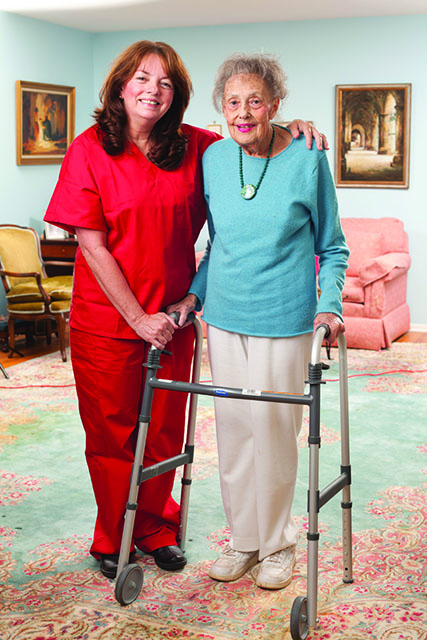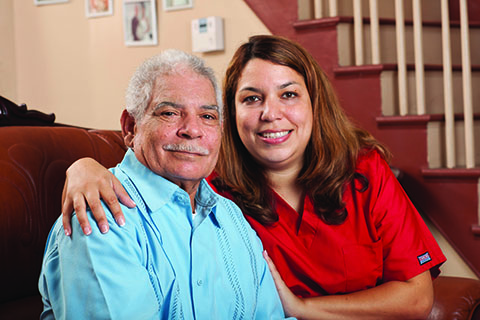COPD Population Management in the Home Health Setting
Posted on December 07, 2016 |

This post was written by Mandeep K Mangat MD, MPH.
I appreciate the opportunity to share my work with you. My name is Mandeep Mangat. For the last 16 years, I have served in various roles in acute and post-acute settings as a physician, a public health professional, and health care administrator. Presently, I lead population health initiatives for BAYADA's Home Health Practice. We have 100 service offices across the nation which help serve communities and families in the provision of nursing, rehabilitative, and therapeutic services to adults at home. Our current focus is on COPD which is one of our top diagnoses in home health.
What is population health management?
Population Health Management--or PHM--is defined as a health-care approach which focuses on “the health outcomes of individuals in a group and distribution of outcomes in that group.” PHM requires an organized system of care to address the engagement of patients across care settings and over time.
Why is population health management the most useful model for the care of chronic patients?
Although 88 percent of the country's health and wellness spending goes toward professional health care, it constitutes a small fraction of what affects a patient’s health. Personal health behaviors such as overeating, lack of exercise, smoking, and drinking are major components of poorer outcomes. Also, social determinants of health, such as income, cultural barriers, health insurance, and the environment in which patients live and access to care affect the overall health of populations. Effective population management includes interventions to moderate these larger determinants of health.

Why is the home health setting a good fit for practicing population medicine?
Home health care teams are uniquely positioned to observe the impact of behavioral and social determinants of health and establish necessary relationships with the patient, family and health professionals across care settings. We take into account every individual that is involved in the care of a patient. While our clinicians provide professional health care, our non-clinician colleagues including social workers and home health aides, assist with a variety of issues including adjustment to illness, cultural factors, financial concerns, community resources and transportation. Our patients are at the center of care and guide our every clinical decision.
What are the key components of a COPD population health initiative?
Successful population health management necessitates creating the conditions in which care teams could become high performing units. We recognize the need to train our teams and empower our patients to self-manage their condition proficiently.
The key components of BAYADA’s COPD initiative include:
- Specialized COPD Care Teams.
- Mandatory Clinical COPD Education. Elevate the knowledge and skills of all clinicians (approximately 2500 clinicians) with a focus on clinical assessment, evidence-based interventions, medication management, and communication.
- Mandatory Non-Clinical COPD Education. Empower non-clinicians to observe individual behavior, social, economic and environmental determinants affecting patient’s health and escalate concerns to interdisciplinary team.
- COPD Certification. Develop COPD leads in 100 service offices by elevating expertise level of experienced and skilled clinicians.
- COPD Patient and Caregiver Self-Management Education. Develop COPD booklet with embedded tools for patient self-management education and counseling.
- Continuous Care. Make providers available to patients during and between home visits; provide telemedicine services to select patients who meet the eligibility criteria; make post-discharge calls within 30 days to ensure patient safety and continued adherence to self-management.
- Coordination across Settings. Efficient use of care transition specialists and clinical liaisons to coordinate patient care and guide them through settings.
- Internal Policies and Procedures. Support alignment of internal policies and procedures with evidence-based training and protocols.
- Clinical Pathways. Integrate evidence-based care plan that details essential steps in the care of patients with a goal to standardize care, improve outcomes and reduce costs.
- Documentation Improvement. Improve clinician skills to ensure accurate and timely clinical documentation which reflects the scope of services provided.
- Measure Success. Use clinical process, outcome and satisfaction measures; track and report findings on consistent basis at a practice level to promote transparency and accountability.

The opportunity to deploy a population health delivery model that can improve COPD health outcomes across our 100 service offices nationwide is truly staggering; however, the greatest risk is posed by the patients we don't see and therefore don’t help as providers. Our at-risk populations may become high risk within short periods of time. As health care providers, it is incumbent upon us to be the eyes and ears of our communities and help identify, keep track of and guide our patients to the right settings so that they can receive the right care at the right time.